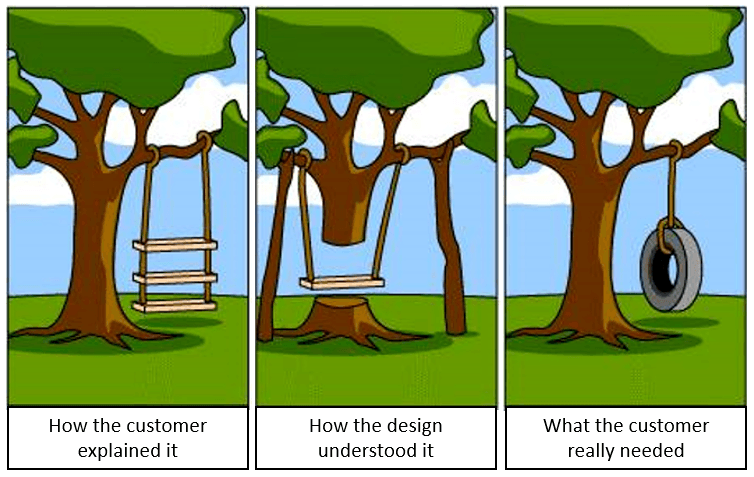How do you whisper about your products?

by Olli Uuttu • 9 min read
As a kid, we sometimes used to play the Chinese whispers game. You probably remember. The game where kids form a line. First player comes up with a message and whispers it to the ear of the second player in the line. The second player repeats the message to the third one, and so on. What typically happens is that the message is garbled on the way. The original meaning differs significantly between the first and last players, which gives joy for all players.

In the field of highly variable and complex products, we have several players in the line. Looking from the customers perspective, there are players who has the need (customer business manager), players who looks from the investment perspective (customers procurement), and players which will daily use the product (customers machine operator), for some to mention. From the manufacturer point of view, we can add players presenting sales, engineering, manufacturing and service.
A complex game
The whispered message itself is also complex and has several viewpoints. There might be hundreds or even thousands of parameters to define, before the message is unambiguous. The parameters that the last player uses are sometimes challenging to understand by the first player. First player defines the need for a certain system or product (volume, process output, etc.) and the last one is mainly interested about the service parameters (service interval, spare part sets, etc.). In between the whispered message is extended with parameters like sales and technical features describing the product variant required (sales), building blocks and components needed (engineering), and production structures together with manufacturing processed required (production).
With highly variable complex products the result is easily garbled and unwanted content of the whispered message we are using. This leads to quality and communication issues related to delivered products that can be illustrated using the “How customer explained it” -meme.

So, in this adult’s Chinese whispers game, our objective is to get things boring. In the end our goal is that all the players have commonly understood the whispered message, since in this game we do not get pleasure from the misunderstanding effect. However, there are couple of other objectives that gives fun and joy for all players together:
- Avoid the “How customer explained it” -meme
- Whisper your message with clear and commonly understood manner
Avoid the “How customer explained it” -meme
In the area of digitalization, a configurator is a solution used to determine, as an automated task, the explicit whispered message used when passing the order through all players. In the end we would get a delivered product the way first players wanted it and a whispered message thread that can be traced between all players. For different players we use different configurators. We use CPQ (Configure, Price, Quote) to define content of quote and order. Product configurators are used to define those building blocks and components that fulfills the order, often defined as EBOM (Engineering Bill of Material). Production configurators are used to define the manufacturing resources, often defined as MBOM and BOP (Manufacturing Bill of Material, Bill of Process).
What do you whisper?
All players have an own way of presenting the whispered message. This easily leads to quality and communication issues about the delivered product. Historically, when talking about highly variable complex products, there has been some reasonable ways to minimize these issues. Staff working for sales has deep knowhow about those complex products offered and even if the quote maybe has been defined in some online CPQ tool by customer, it still has been evaluated by those skilled sales representatives, before the order is placed. So, in other words, the player working close to sales is constantly listening and understanding what the earlier players in the line are whispering. This has been to some extent possible, especially when the product offering spread to market has been relatively stable over time.
Today, due to manufacturing industry trends like increasing customer expectations, shorten product launch cycles, and rising operational costs, this game setup is changing. Increasing number of customer expectations means higher variety of whispered messages given by the first players. This together with the fact that new generations do not have decades of knowledge about the different technical product variants offered especially in global environments, means that configurators need to understand and guide customer to the solution really wanted. And at the same time, due to shorten product launch cycles, the offering is constantly evolving.
What customer wants?

So, in the area of digitalization, we need to more and more capture and understand what the first players in the line are whispering. This leads to extend our configurator capabilities in the area of Customer Experience. Gartner defines Customer Experience as the customer’s perceptions and related feelings caused by the one-off and cumulative effect of interactions with a supplier’s employees, systems, channels or products.
Figure above illustrates a typical Customer Experience flow. During the awareness and consideration phases customers has some needs and are iterating possible solutions to fill those needs. When advancing towards buying phase more and more detailed list of features describing the needed product is defined. Today, an emotionally positive experience within this flow is mainly based on highly skilled people, tomorrow we need to boost their work by extending configurator capabilities to the area of digitalized customer experience. So, we need digitalization to guide customer to understand what they want.
Whisper your message with clear and commonly understood manner
As said earlier, in the field of highly variable and complex products, the whispered message itself is complex and has several viewpoints. Product is defined using somewhat different parameters when talking with sales, engineering, production and service. Figure below illustrates some common configurator related phases used in this flow called as Factory excellence. In the end our goal is to reduce the number of assets needed to configure an optimal portfolio of product variants to meet the desired customer value. But, as it is common with complex problems, there is not out there one simple medicine to meet this goal. However, by following some best practices you can run your business towards this goal.

It all starts from minimizing the impacts of complexity by developing modular product architectures. As often underestimated, the most critical part of modularization is understanding customer segments, related needs, and their value. This gives the required space for variability. This is followed by defining a modular system, an optimal solution to meet that variability. Modularity is an objective for all stakeholders and drives simplicity and common understanding for the whispered message you are using within your game.
What customer gets?
Imagine a clearly understood whispered message. Something that is easily understood nevertheless of the players background and is transferred to the following players with no errors. Boring, when kids are playing the Chinese whispers game, but ideal for our game to reach the factory excellence. In the field of configurators and PLM (Product Lifecycle Management), this clearly understood whispered message can be called as the shared product definition. The shared product definition secures smooth collaboration between all stakeholders and enables you to drive efficient product lifecycle processes on top of rich data to continuously improve products, drive down product cost through efficient sourcing, improve production processes and improve service/maintenance processes.
When starting to play the Chinese whispers game, first rounds typically take time. Players may be new to each other. They are figuring out what the earlier player said and thinking how to pass it to the next one. After some rounds, players have learned about each other and often about the typical message subjects. But then, suddenly, the first player in line figures out a message that significantly differs from earlier ones, maybe something little embarrassed. That round takes some time again. After some rounds other players has learned those embarrassed topics, and the game can feel boring for the kids.
Secure wants equal to gets
When talking about highly variable complex products, most likely we need to deal with both types of messages. Sometimes we have a message that is familiar with all players. In that case, we can run the configuration process end-to-end smoothly. All players understand the message, has the needed knowhow and resources ready to run their part efficient and such a way that next player can carry out their task with minimum lead time. In these cased we are running the game in so called CTO (Configure-to-Order) mode. Then, suddenly, we have some completely new message content, and we need to run the game in so called ETO (Engineering-to-Order) mode.
By adopting the ways-of-working related to customer experience, modularization and shared product definition we can optimize the game rounds with commonly learned message topics and therefore reduce the lead time. So, in other words increase the amount of CTO’s. This gives us also a base to learn from ETO’s and therefore optimize the balance in between ETO and CTO. As a result, we have optimized our process to deliver what customer wanted.

Whispering your products
When playing the “adults Chinese whispers game”, your goal is to improve the game lead time and remove all garbles. In order to achieve this goal, my advice is to:
- Figure out your configurator processes end-to-end, from customer experience all the way to factory excellence
- In your configuration process increase agility by understanding different business drivers between Customer Experience (WANTS) and Factory Excellence (GETS), and secure wants equal to gets
- Constantly work with product modularization to understand the required space for variability, and to find an optimal solution to meet that variability
- Enable the shared product definition, a digital thread that secures smooth collaboration between all stakeholders
An optimal result of this game gives us minimum number of surprises related to the output of the game. The pleasure comes from better value for customer and increased profits. Enjoy this spared time with your kids, for instance playing the Chinese whispers game.
EVIDEN can help you towards customer experience driven plm!
At EVIDEN we work with companies offering highly variable products across the Nordics and Baltics. Want to know more!
More posts

Metso aiming to improve supply chain collaboration through system simulation
Webinar (THIS WEBINAR WILL BE HELD IN FINNISH LANGUAGE) (Material will be distributed in English) August 22, 2023 – 09:00 CET Learn how Metso utilizes system simulation in their hydraulic system design. Research engineer Jesse Backman shares his learning path to system simulation, and how Metso could improve the collaboration of the supply chain through […]

Metso pyrkii kehittämään toimittajayhteistyötä systeemisimuloinnin avulla
Webinaari 22.8.2023 – 10:00 EET Tule kuulemaan kuinka Metso hyödyntää systeemisimulointia hydraulijärjestelmien suunnittelussa. Tutkimusinsinööri Jesse Backman kertoo oppipolkunsa systeemisimuloinnin pariin ja kuinka Metso voisi kehittää yhteistyötä toimittajaketjussaan systeemisimuloinin avulla. Tärkeimmät opit esitellään käytännön suunnitteluesimerkin avulla. Kuinka parantaa yhteistyötä toimitusketjussa systeemisimuloinnin avulla? Mitä systeemisimulointi on? Systeemisimulointi yhdistää yksittäisten komponenttien ominaisuudet ja vuorovaikutukset koko järjestelmän dynaamiseksi käyttäytymiseksi. […]

From Chaos to Clarity: Embracing Modularity
by Olli Uuttu • 8 min read Dear reader, have you ever wondered what goes into building a truly modular product? It’s not as easy as it may seem. While there are several proven methods available to plan and implement optimal modular architectures, it still takes effort, dedication, and discipline to succeed. I’m sure you […]